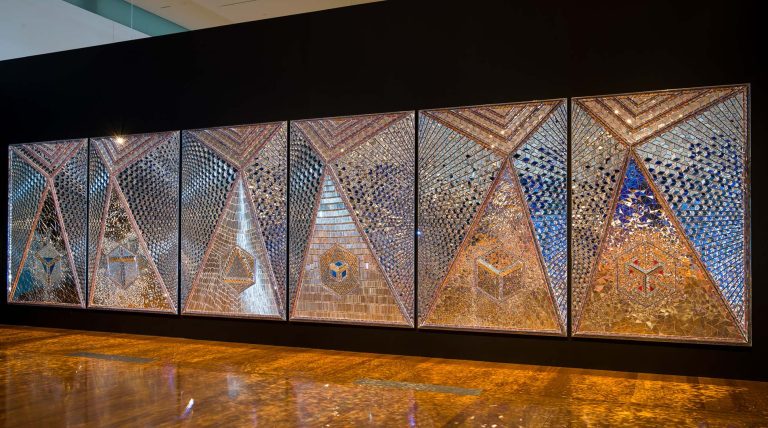We acknowledge the Traditional Owners of the land on which the Queensland Art Gallery | Gallery of Modern Art stands and recognise the creative contribution First Australians make to the art and culture of this country.

Monir Shahroudy Farmanfarmaian / Iran 1924—2019 / Lightning for Neda (installation view) 2009 / Mirror mosaic, reverse-glass painting, plaster on wood / Six panels: 300 x 200 x 25cm (each); 300 x 1200 x 25cm (overall) / The artist dedicates this work to the loving memory of her late husband Dr Abolbashar Farmanfarmaian. Purchased 2009. Queensland Art Gallery Foundation / Collection: Queensland Art Gallery | Gallery of Modern Art / © Estate of Monir Shaharoudy Farmanfarmaian / Photograph: Natasha Harth, QAGOMA
Monir Shahroudy FarmanfarmaianLightning for Neda 2009
Not Currently on Display
The characteristic mirror mosaic of Monir Shahroudy Farmanfarmaian’s work is an Iranian decorative form known as ‘aineh-kari’. As curator Rose Issa has commented:
The technique dates back to the 16th century, when mirrors were imported from Venice and Bohemia to Iran and arrived broken. The new owners had to find imaginative ways of recycling these shards of glass, and would set the pieces in stucco to create decorative panels with attractive multiple reflections. As well as Sufi symbolism of reflecting the self, mirror has since been associated with purity, brightness, symmetry, veracity and fortune.1
In Lightning for Neda, Farmanfarmaian has constructed six panels of over 4000 mirror shards explore the geometric possibilities offered by the hexagon. The hexagon represents the six directions of motion (up, down, front, back, right, left) and the six virtues of generosity, self-discipline, patience, determination, insight and compassion. Essentially abstract, Lightning for Neda draws on the Islamic use of geometry to structure and develop complex architectural ornamentation.
The title of the work pays homage to Neda Soltani, a 16 year-old Iranian female student killed in the streets of Tehran during the pro-democracy protests that followed the 12 June 2009 presidential elections. Neda means ‘voice’ in Farsi, and here, the compelling voice of the artist acknowledges the turmoil facing her country.
Over a career that spans many decades, Monir Sharoudy Farmanfarmaian has created an art that is imbued with the aesthetics of her Iranian culture. Inspired by its architecture and the traditions of Islamic geometry and pattern, as well as techniques such as reverse-glass painting, mirror mosaic and relief sculpture, Farmanfarmaian has revived and adapted these forms to make startlingly original and compelling works. She wanted to be an artist from the outset, enrolling in the Fine Arts College at Tehran University in the early 1940s before venturing to New York at the age of 22 to study fashion illustration at Parsons School of Design. On graduation, she pursued a career as a successful commercial graphic and fashion designer, until 1957 when she returned to Iran to seriously develop her artistic practice.
In Tehran, Farmanfarmaian began actively collecting cultural material including antique reverse-glass paintings, highly coloured images prevalent in Tehran’s coffee houses1, Turkoman tribal textiles and silver jewellery2 , and architectural fragments such as doors, windows, and wall panels. Much of this activity was done in the spirit of recovering material culture that was rapidly disappearing, with the aim of gifting them to Iranian state art collections, especially as they were not objects considered fashionable at the time. Immersing herself in this material and developing her own artistic language became interdependent activities for Farmanfarmaian, forming and maturing into a unique practice.
Endnotes:
1 Coffee houses in Tehran are traditionally male-only establishments. Their walls are generally hung with stylised, highly coloured paintings of religious and national heroes. These works are identified as being made at the cusp of the Constitutional Revolution (1906—11).
2 The Turkoman are a formerly nomadic tribal people from the region encompassing Turkmenistan, Afghanistan, northern Iraq and north-eastern Iran.